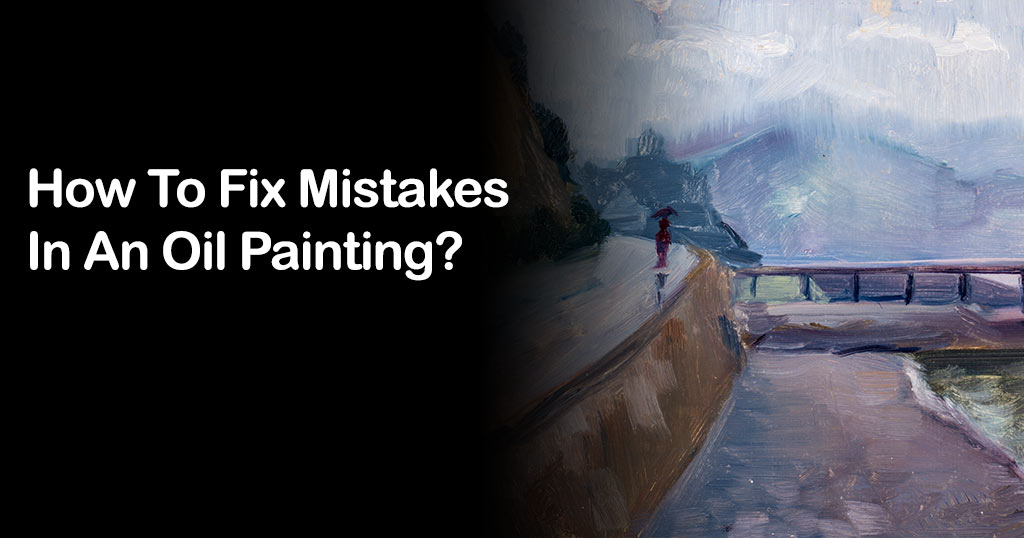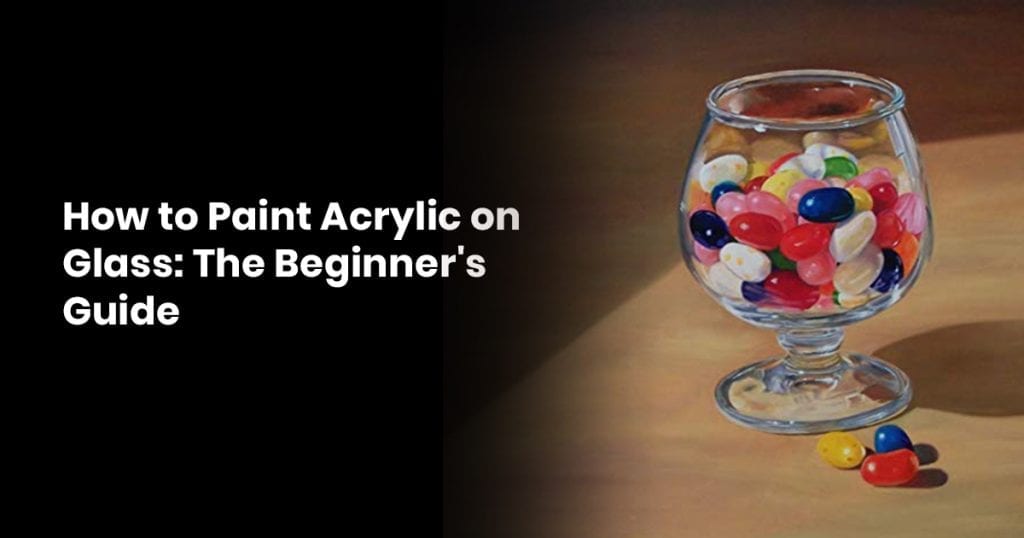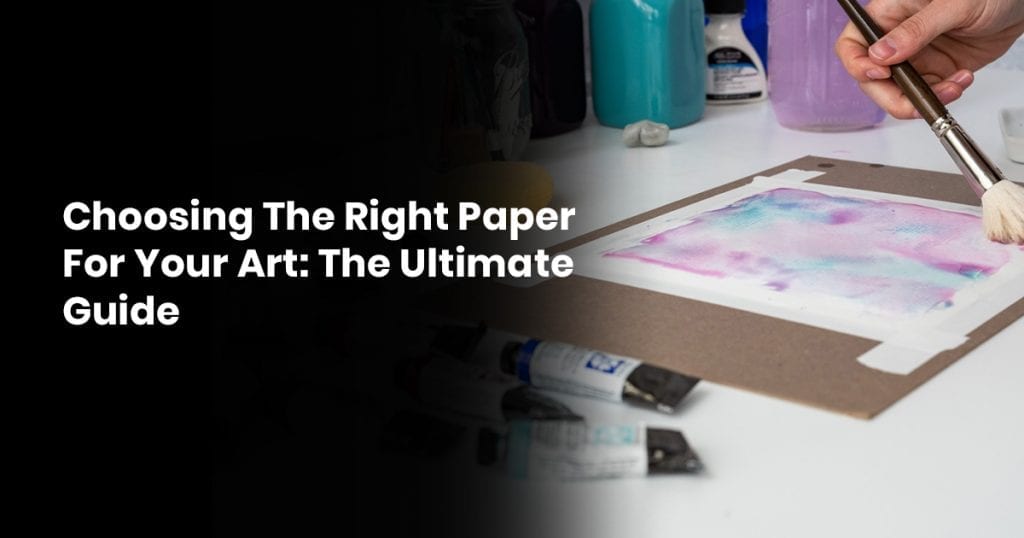Nobody is perfect, and this means that we all make mistakes. This same principle also applies to painting. Sometimes you mess around with a specific area of a painting too much and it no longer fits with the rest of the painting which can result in the colors becoming muddy in nature, the texture building up too much, or it just not working out the way you planned at all. Some artists have no idea how to even approach this situation, and often just restart the entire painting process.
Now, although it can be extremely frustrating to make a mistake on a painting, you do not have to abandon the entire piece of art. It is possible to fix mistakes in both oil and acrylic paintings. Many people are unaware of this; however, you do not have to restart every time you make an error. Therefore, before you throw the painting away, take a step back, followed by a deep breath, and follow the steps provided in this article to rectify the mistake you have made.
Contents
Determine the Best Approach
Before you address the issue at hand, you must be able to look at your artwork objectively. This is often difficult to do at the moment you make the mistake, so going for a walk or doing something to clear your mind is always a good idea. Doing so can help you create a fresh perspective, as well as allowing you to analyze the painting without any emotions becoming involved.
As an artist, it is entirely normal to get emotionally involved in your paintings; however, when something goes wrong, it only builds frustration. This can result in you trying to fix the mistake without thinking it through properly, which, doing this can create even more problems than you had in the beginning.
An example of this would be an artist being tempted to paint over a shadow that just does not seem right. However, if they do not allow the black or deep-tinted paints to dry before applying any white to the area, the color tends to bleed through. This can result in a seemingly endless cycle of unnecessary paint buildup that does not match the rest of the painting.
Before attempting to fix any mistake on a painting, you should ask yourself if the paint has dried yet, as well as if you have the patience to deal with it while it is still wet. If you do not have the patience to deal with wet paint, then you should walk away, let it dry, and come back once you can correct the error.
Regardless of whether the paint you use is acrylic, oil, wet or dry, it is entirely possible to remove the mistake you have made and start again with a white background in the area. You should keep in mind that as you build up, remove and build up the paint in the area, you may lose some of the original texture of the surface you are using.
It is especially important to make this consideration when working with canvas because the rest of the paint is thinly layered, thus showing the texture beneath it. It is not always noticeable; however, you should be aware that it could prove to be an issue.
How to Correct Painting Mistakes
When it comes to the correction of errors in painting, your best friend is always going to be a tube of titanium white. It is extremely opaque, and its warm white color can cover any color or pigment in a few thin coats of application.
Many artists make the mistake of only adding a single coat of titanium white over the mistake, and then continuing with the painting. Problems can arise when doing this, as the new pigments you apply can become tinted by the colors you have tried to cover up. This often results in the colors not being as true and thorugh as you were expecting them to be.
For this reason, you should make sure to apply at least two coats of the titanium white, with the second coat only being applied after the first has dried. By doing this, you have a clean white base to paint on. Rushing the process can end up causing more damage than the original mistake, so take your time to let it dry properly.
Many painters make the common mistake of using zinc white instead of titanium white. This is a problem as zinc white is more transparent than titanium white which causes obvious problems, as the zinc white does not provide the type of coverage needed to fix mistakes. Should the tube say “mixing white” or something similar to that, you should check the label information to see what type of white it is.
Titanium white is often viewed by painters as an eraser of sorts. When using it though, you have to remove any texture, paint ridges, or impasto in an attempt to get as close to the original texture of the painting as possible.
How do you Fix a Mistake in an Oil Painting?
Oil paints tend not to dry as quickly as those of the acrylic variation. For this reason, many painters choose to fix mistakes in oil paintings while the paint is still wet. Some of these techniques can still be used when attempting to fix mistakes in acrylic paintings; however, they are primarily used for oil paint.
By following the tips and techniques listed below, you can correct any mistake that you happen to make with oil paint as soon as you make it. Here are some of the techniques that are most effective when attempting to correct a mistake in an oil painting:
- Scraping off the wet paint with either a painting knife, thick piece of paper, or even an old credit card is an effective way of quickly correcting the mistake that you just made. You must do this as soon as possible.
- After you have scraped off the paint, you should wipe away the paint that has been left behind with a soft cloth until you have removed as much as you can. Make sure not to drag the cloth across other areas of wet paint as this can just cause more problems that you have to deal with.
- When it comes to oil paint, adding some linseed oil to the cloth is a great way to get rid of any excess paint. For acrylics, water is fine. Regardless of whether you are using linseed oil or water, make sure not to make the cloth too wet, as this can result in the liquid running down the painting.
- After having cleaned as much paint as possible, you should allow the area to properly dry. This drying process can take between two to three days for oil paintings.
- Once the area has dried, add some titanium white to the area. Make sure that you allow each layer to dry properly before applying the next one.
- Once the titanium white has dried, you can continue with your painting as if no mistake had been made in the first place.
When it comes to oil paintings, tonking is another method that can be used. Although this is primarily used to add texture to thick paints, it can also be used to remove some painting mistakes. If you are interested in using this method, it involves the following steps:
- To start this process, tear a piece of paper, preferably newspaper, to the approximate size of the area that you want to remove paint from.
- Then, apply the paper to the wet paint and press it down with your hands. You can provide support to the back of the canvas with the palm of your other hand if needed.
- You can then gently pull the paper away from the canvas.
- You should then continue this process with clean paper as many times as you have to, or until no more paint appears on the paper you are using.
- Once you have completed this process, you can use a cloth with some linseed oil to clean off the excess paint and wait for the area to dry.
By following either of the two methods provided, you can fix almost any mistake that you make on an oil painting. Oil paint offers you the benefit of correcting the mistake before it has dried. Therefore, if you make an error, you should try to correct it as soon as possible if oil paint is your chosen medium. Whether you choose to scrape the paint away or use tonking, you can easily rectify any mistake that you have made, without having to restart the entire painting.
How do you Fix an Acrylic Paint Mistake?
Acrylic paint tends to dry quickly, especially in comparison to oil paint. For this reason, you have to correct mistakes on acrylic paintings once the paint has dried. Some of the techniques can also be used on dry oil paints; however, they are most often used to fix mistakes in acrylic paintings.
Thus, if you have made a mistake on your acrylic painting and are looking for a way to correct the error, here are some tips on how to do so:
- By using very fine sandpaper, you should gently sand the area that you want to paint over and correct it.
- Sometimes you may find that some of the paint layers beneath the top one are still wet. Should this be the case, you can use a paint knife or any of the other tools mentioned for removing wet oil paint to remove the wet layers.
- You should continue to remove the paint until you reach the surface that you have been painting on.
- You can then use a damp cloth (damp with water for acrylics) to remove any paint or dust that has been left behind. This prevents any unwanted textures or tints from affecting the painting.
- You should then allow the area that you have worked on to dry before attempting to do anything else. Due to you using acrylic paint, the area should dry relatively quickly.
- Once the area has dried, apply two layers of titanium white. You should allow these layers to properly dry before attempting anything further.
- Once the layers of titanium white have dried, you can resume with the painting. You can correct the mistake by painting over the area you have just worked on.
By following these steps, you can easily rectify any mistake that you have made on an acrylic painting. This can save you a ton of time, as you do not need to start the entire process from scratch every time you make a mistake. You must follow all of these steps properly, if you rush through any of them, you may find that you are causing more problems than you are solving.
Waiting for the paint to dry is an extremely important step, as if you try this method with wet paint, you may find it extremely difficult to fix the mistake. It could result in you damaging other parts of the artwork that did not need any work done to them. By following the steps provided here, you can correct any mistake on an acrylic painting.
How do you Fix Lumpy Acrylic Paint?
Painting with acrylic paint is great due to them having extremely vibrant colors, coupled with much faster drying times than other types of paint. The problem with the drying time of this type of paint is that sometimes it can dry before you have finished painting, resulting in it getting lumpy in the palette or worse, on the painting itself.
The paint can also become lumpy inside the bottle, stopping you from painting when you want to do so. This can be very frustrating and can even result in you not wanting to use acrylic paint anymore. However, it is possible to fix this problem, and we detail how to do so here.
The first, and probably most troubling issue of lumpy acrylic paint is when the lumps form on the painting. If this should happen, you may be extremely worried and think that you have to restart the entire painting. Luckily, this is not the case. The issue can be resolved relatively easily, and you do not need to worry about it too much.
Although lumps on the painting can be unsightly, the problem is not too serious. Should you notice any lumps on your painting you should do the following:
- Place the painting on a hard and even surface. This makes the process much easier, and you do not have to worry about making a mistake as a result of the painting slipping or being unstable.
- After placing the painting on a hard and even surface, you want to start gently wiping the painting with a cloth to remove any dust. It is important that you only do this once the painting has dried to avoid obvious complications. Removing any dust is crucial to the process, as not doing so can cause further problems down the line.
- Next, you want to make sure that you have some sandpaper on hand. It is recommended that you use sandpaper with a grit of about 220 or more. Using a sandpaper that is too rough can ruin the painting, so a finer option works best.
- Now, you want to start gently sanding the affected area. You want to lightly go over any bumps that you notice in the painting. Make sure not to apply too much pressure as this can end up removing some of the paint. Ensure that you apply consistent pressure while doing this so that all the lumps on the painting look even. You should notice that the lumps begin to gradually go away, eventually leaving the painting without them at all.
- Although the process is time-consuming, it is much more efficient than restarting the entire painting. After you have completed sanding the affected area, you may want to repaint the area. You can make use of a darker color for extra coverage if you so desire.
This method is extremely useful and can save you tons of time. By removing any lumps in the painting, you can have it looking pristine once again. Therefore, do not worry too much if you notice any lumps on your acrylic painting, as they can be easily dealt with by sanding them down.
Sometimes the paint can become lumpy in the containers it is stored in. This can become extremely frustrating when you want to work on the artwork you are currently creating. The paint often becomes lumpy as a result of the lid not being closed properly, or the paint just becoming too old. Storing the paint in the wrong temperature conditions can also result in it becoming lumpy.
Moreover, keeping all this in mind, how do you fix the paint once it has become lumpy? The answer to this problem is rather simple. You can add some acrylic paint thinners to the container and begin mixing it until you no longer feel any clumps. There are a variety of paint thinners that work well for this, and if you are unsure, your local art supplies store can be of assistance in this regard.
However, sometimes the paint can become too dry, making the process irreversible. If this is the case, you are better off just buying some new paint. Keep in mind that prevention is always better than cure. Thus, if you notice that your acrylic paint is always drying up or becoming lumpy, there is a clear issue with the way that you are storing it.
Storing your paint properly can save you from having to deal with this issue, as well as saving you money in the long run. Here are some storage tips for your acrylic paint to avoid having to deal with them drying up or becoming lumpy.
- Close the lids properly after use. It is crucial that you properly close the paint containers after you are done using them. If they are not closed correctly, air can get inside the container, causing the paint to start drying and forming lumps. You can take extra care to close the lids after use to prevent this from happening.
- When storing your acrylic paint, make sure to store it in an airtight container. This prevents any air from causing the paint to dry, even if you have been careless and not closed the container properly. The paint should also be stored away from wet and damp locations. These conditions can cause a host of problems for the paint. It is always best to store them in a dry area such as a cabinet. The ideal temperature to store acrylic paints is between 65 and 75 degrees Fahrenheit.
By storing your paint in these conditions, you do not have to worry about it becoming lumpy in its container.
The Bottom Line
After reading this article you should be more confident in dealing with any mistakes in your paintings. Regardless of whether you prefer to use oil or acrylic paint, you can correct any mistakes that you have made.
You no longer have to start over when you make an error but can rather just rectify the mistake and continue with the painting. Therefore, bring your ideas to life without the fear of having to restart any painting ever again.




